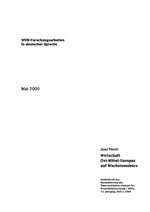Wirtschaft Ost-Mittel-Europas auf Wachstumskurs (Reprint from: WIFO-Monatsberichte, Vol. 73, No. 5, May 2000)
Josef Pöschl
wiiw Research Report in German language No. 2000-05, May 2000
CEECs on Track for Economic Growth
More or less all Central and East European transition countries (CEECs) experienced an economic downturn in 1998, which bottomed out in the winter of 1998-99. Year-on-year GDP data point to decelerated growth in the fourth quarter 1998 and in the first quarter 1999 in a smaller subgroup (Hungary, Poland, Slovakia and Slovenia) and GDP decline in others (the Baltic states, Bulgaria, Croatia, the Czech Republic, Romania, Russia). In nearly all CEECs the situation improved in the course of 1999. In Russia, the currency crisis of August 1998 led to substantial depreciation, which in 1999 stimulated domestic production. Regional trading partners of Russia (the Baltic states, Ukraine and to a lesser degree also Bulgaria and Poland) started to recover from the breakdown of Russian demand for their exports. The Czech Republic, Hungary, Poland and Slovenia profited from an improving business climate in Germany, their most important trading partner. Home-made policies supported the upswing - especially a decline in interest rates in most of the countries, which also helped to keep real currency appreciation moderate. Inflation increased somewhat in the CEECs with lower inflation rates when world market prices for oil started to rise. Inflation in the CEECs is not expected to come down to Western European levels in the immediate future, a fact which will make it difficult to find an adequate interest rate policy.
The degree of economic inequality between CEECs is remarkable. Thus, differences in the per-capita GDP are greater in these countries than in the EU. In addition, price levels, recalculated in USD terms, are more divergent between them than between western countries.
The year 2000 could become the first year in which CEE economies record no shrinking of GDP. Even Russia has at last entered a path towards growth. Next year, growth could even strengthen and the more successful countries (currently Hungary, Poland and Slovenia) may be able to lower their income gap relative to the EU.
Zusammenfassung
Im Jahr 2000 könnte erstmals keines der Transformationsländer Ost-Mittel-Europas mehr einen Rückgang des Bruttoinlandsproduktes verzeichnen. Seit Mitte 1999 hat sich die Wirtschaftslage in allen Ländern verbessert, allerdings von sehr unterschiedlichem Niveau aus. Für die russischen Produktionsbetriebe erwies sich die Rubelabwertung, eine Folge der Währungskrise im August 1998, als zentraler Impuls, für die westlichen MOEL der Wirtschaftsaufschwung in Deutschland. Positiv wirkte sich in den meisten Ländern auch das Sinken des Zinsniveaus aus.
